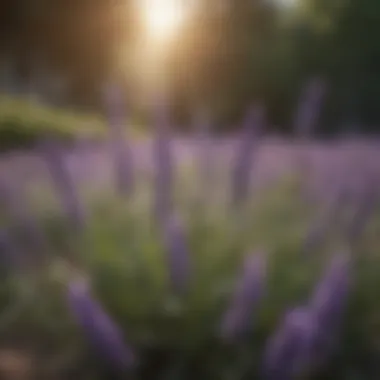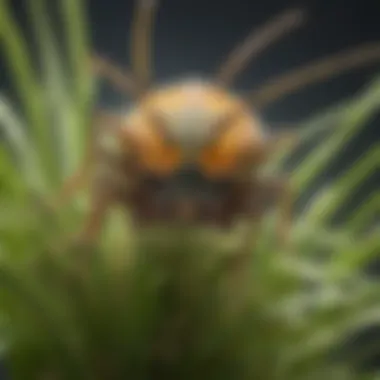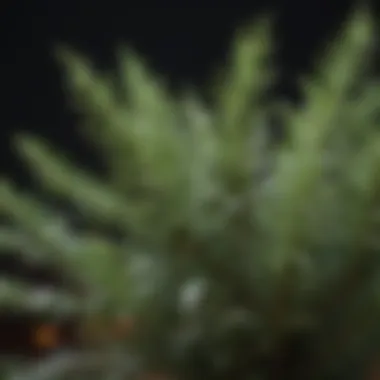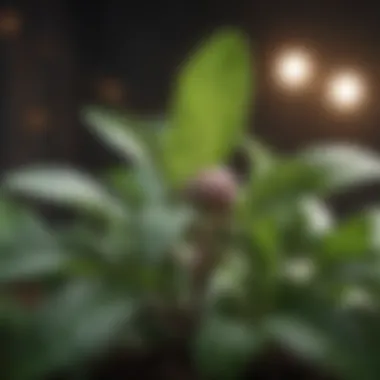Naturally Repelling Stink Bugs: Plant-based Solutions Unveiled


Preventive Pest Control Strategies
When it comes to effectively managing stink bugs and other pests in your home and garden, implementing preventive pest control strategies is paramount. A proactive approach can significantly reduce the need for harmful chemicals while maintaining a pest-free environment.
House Exterior Protection
Taking the time to inspect and secure your house's exterior is a fundamental step in stink bug prevention. Start by carefully sealing any cracks or gaps around windows, doors, and foundations to block potential entry points for pests. Additionally, regular yard maintenance is key to reducing stink bug habitats. By keeping your outdoor space tidy and free of debris, you can create an inhospitable environment for pests. Lastly, implementing strategies to prevent pests from entering your home, such as installing mesh screens on windows and doors, can further fortify your defenses against stink bugs.
Yard Maintenance
An essential aspect of preventing stink bugs is maintaining your yard to deter these pests from taking up residence. Consider implementing yard care routines that discourage stink bugs, such as regular mowing, pruning, and removing stagnant water sources. By consistently keeping your yard well-manicured and free of clutter, you can limit the attractiveness of your space to stink bugs and other unwanted critters.
Indoor Cleanliness
Maintaining a clean and clutter-free indoor environment is crucial in stink bug prevention. Expert cleaning tips and techniques, such as vacuuming regularly, storing food in airtight containers, and sealing cracks in walls and floors, can help eliminate potential hiding spots for stink bugs. By adopting a vigilant approach to indoor cleanliness, you can create an inhospitable environment for stink bugs and other pests.
Garbage Disposal
Proper garbage disposal is a key component of effective pest control. Dispose of waste efficiently by securing trash in tightly sealed bins and disposing of garbage regularly. Always ensure that compost heaps are properly managed to prevent attracting stink bugs and other pests. By prioritizing proper garbage disposal practices, you can significantly minimize the risk of stink bug infestations in your home.
Other Pest Prevention Strategies
In addition to the aforementioned preventive measures, various innovative strategies can aid in safeguarding your home against stink bugs and other pests. Regularly inspecting and maintaining your home's exterior, implementing natural deterrents such as cedar wood chips or essential oils, and considering eco-friendly pest control products are all valuable tactics to incorporate into your pest prevention regimen. By combining multiple prevention strategies, you can bolster your defenses against stink bugs and ensure a pest-free living environment.
Understanding Stink Bugs and Their Deterrents
Stink bugs pose a common nuisance in gardens and households, prompting the need for effective natural deterrents. By comprehensively understanding stink bugs and the deterrence methods available, individuals can safeguard their plants and homes without relying on chemical solutions. This section sheds light on the crucial elements and benefits of understanding stink bugs and their deterrents.
Characteristics of Stink Bugs
Physical Appearance


Stink bugs are characterized by their shield-shaped bodies and distinctive coloration, often in shades of green or brown. This physical appearance serves as a key identifier for homeowners and gardeners to spot these pests. While their camouflaged exterior aids in blending with plant foliage, it also makes them challenging to detect. Understanding their physical appearance is essential for early identification and implementing necessary control measures.
Feeding Habits
Stink bugs are herbivores known for piercing plant tissues and feeding on sap, resulting in wilting and damage to various crops. Their feeding habits not only jeopardize plant health but also lead to economic losses for farmers. Recognizing their feeding patterns enables individuals to select plant varieties that are less attractive to stink bugs, fostering a pest-resistant environment.
Habitat Preferences
Stink bugs thrive in warm climates and are commonly found in agricultural fields, orchards, and gardens. Their habitat preferences include areas abundant in vegetation and suitable temperatures for breeding. Knowing stink bugs' favored habitats aids in deploying targeted preventive strategies, such as manipulating environmental conditions to deter their presence.
Natural Deterrents to Stink Bugs
Plants with Repellent Properties
Certain plants possess natural repellent properties that stink bugs find unappealing, thereby acting as a deterrent. By incorporating these plants into gardens or homes, individuals can create an inhospitable environment for stink bugs, reducing infestations organically. Understanding the characteristics of such plants and their repellent properties is crucial for effective stink bug control without resorting to harmful chemicals.
Environmental Factors Influencing Stink Bug Behavior
Stink bugs' behavior is influenced by environmental factors such as temperature, humidity, and vegetation density. By modifying these factors within a garden or agricultural setting, homeowners can manipulate stink bugs' behavior and movement patterns. This knowledge allows for the proactive management of stink bug populations, enhancing the overall effectiveness of natural deterrents.
Plant Varieties Known to Repel Stink Bugs
Herbs and Aromatic Plants
Mint:
Mint, with its strong scent, is a notable plant variety known for repelling stink bugs effectively. Its aromatic properties act as a natural barrier, deterring these insects from infesting your garden. Mint is a popular choice due to its versatility in culinary use and its ability to ward off pests naturally. However, it's essential to plant mint strategically as it can spread rapidly and overtake other plants.
Basil:
Basil, another herb with strong repellent properties, plays a significant role in deterring stink bugs. The unique fragrance of basil is unappealing to these insects, making it an excellent addition to your pest management strategy. Basil is not only beneficial for repelling stink bugs but also adds flavor to your dishes, making it a dual-purpose plant in your garden.


Lavender:
Lavender, known for its calming aroma and vibrant purple flowers, serves as a natural deterrent to stink bugs. The distinct scent of lavender disrupts the sensory receptors of stink bugs, keeping them at bay. Apart from its pest-repellent properties, lavender enhances the aesthetic appeal of your garden and attracts beneficial pollinators, creating a harmonious ecosystem.
Flowering Plants
Marigolds:
Marigolds are renowned for their vibrant colors and natural pest-repellent qualities, including stink bugs. The strong aroma emitted by marigolds acts as a deterrent, protecting your plants from stink bug infestations. Additionally, marigolds are easy to grow and maintain, making them a popular choice for both experienced and novice gardeners.
Chrysanthemums:
Chrysanthemums, with their aromatic blooms and diverse colors, are effective in repelling stink bugs naturally. These flowering plants contain pyrethrum, a natural insecticide that deters various pests, including stink bugs. Integrating chrysanthemums into your garden not only enhances its visual appeal but also provides a sustainable pest control method.
Petunias:
Petunias, known for their trumpet-shaped flowers and vibrant hues, offer a practical solution for stink bug prevention. The strong fragrance of petunias acts as a natural repellent, discouraging stink bugs from invading your garden. These low-maintenance flowering plants are a valuable addition to any garden seeking an aesthetically pleasing and pest-resistant landscape.
Vegetables and Fruits
Tomatoes:
Tomatoes, besides being a staple in many gardens, possess natural compounds that deter stink bugs. The odor released by tomato plants acts as a repellent, keeping stink bugs away from your crops. Growing tomatoes not only provides a bountiful harvest but also helps protect your other plants from stink bug damage.
Peppers:
Peppers, like tomatoes, emit a distinct aroma that stink bugs find undesirable. Incorporating pepper plants into your garden not only adds diversity to your produce but also serves as a natural barrier to pest infestations. Peppers are a versatile vegetable that complements various dishes while contributing to your pest control efforts.
Cucumbers:
Cucumbers, with their crisp texture and refreshing flavor, also act as a natural deterrent to stink bugs. The compounds present in cucumber plants repel stink bugs, safeguarding your garden from potential damage. Growing cucumbers not only ensures a fresh supply of this hydrating vegetable but also helps maintain a pest-free environment in your garden.


Perennial Shrubs
Rosemary:
Rosemary, a fragrant perennial herb, serves as an effective deterrent to stink bugs. The strong scent of rosemary repels these insects while offering culinary benefits. With its evergreen foliage and aromatic leaves, rosemary is a versatile shrub that enhances your garden's aesthetics and repels pests naturally.
Sage:
Sage, known for its culinary uses and medicinal properties, is also valuable in deterring stink bugs. The pungent aroma of sage acts as a natural insect repellent, making it a practical choice for pest control. Cultivating sage not only enriches your culinary creations but also contributes to a healthier and pest-resistant garden.
Thyme:
Thyme, with its delicate leaves and earthy fragrance, plays a vital role in repelling stink bugs naturally. The aromatic compounds in thyme plants create an unwelcoming environment for stink bugs, preventing infestations. Thyme not only adds flavor to your dishes but also serves as a low-maintenance perennial shrub that enhances your garden's biodiversity while warding off pests.
Creating an Integrated Approach to Stink Bug Control
Creating an integrated approach to stink bug control is imperative for effectively managing these pests in a natural and sustainable manner. By combining various strategies and elements, one can significantly reduce stink bug populations without the need for chemical interventions. This holistic approach not only targets existing stink bug issues but also works towards preventing future infestations, promoting a healthy ecosystem in your garden.
Companion Planting Strategies
Plant Pairing for Enhanced Pest Repellency
Plant pairing for enhanced pest repellency is a fundamental aspect of integrated stink bug control. By strategically placing companion plants with natural deterrent properties near susceptible crops, you can create a protective barrier against stink bugs. The key characteristic of plant pairing is its symbiotic relationship, where certain plants help repel pests, while others attract beneficial insects that feed on stink bugs. This mutual interaction enhances the overall pest resistance of your garden, fostering a balanced environment devoid of harmful chemicals. However, it is crucial to research and understand the specific plant pairings suitable for your region and crop types to maximize their effectiveness.
Beneficial Insect Attraction
Beneficial insect attraction is another vital component of companion planting strategies for stink bug control. By incorporating plants that attract predatory insects such as ladybugs, lacewings, or parasitic wasps, you can introduce natural predators that feed on stink bugs. These beneficial insects serve as biological control agents, helping to maintain stink bug populations at manageable levels. The key characteristic of beneficial insect attraction is the sustainable and eco-friendly pest management methodology it offers. While attracting beneficial insects can be highly effective in reducing stink bug numbers, it is essential to carefully select plants that cater to specific predator preferences to ensure optimal pest control outcomes.
Cultural Practices for Stink Bug Prevention
Mulching Techniques
Employing mulching techniques is a cornerstone of cultural practices for stink bug prevention. Mulching not only aids in retaining soil moisture and preventing weed growth but also acts as a physical barrier that deters stink bugs from infesting your plants. The key characteristic of mulching is its dual functionality, providing both protection and nourishment for your garden. While mulching can significantly reduce stink bug populations, it is crucial to choose the right type of mulch and apply it correctly to avoid creating favorable habitats for stink bugs.
Crop Rotation Benefits
Implementing crop rotation benefits contributes significantly to stink bug prevention by disrupting their feeding and breeding patterns. Rotating crops prevents stink bugs from building up large populations and reduces the risk of infestations in successive growing seasons. The key characteristic of crop rotation is its ability to break pest cycles naturally, minimizing the reliance on chemical interventions. While crop rotation offers multiple advantages in terms of pest control and soil fertility, it is essential to plan rotating crops strategically to maximize its effectiveness and prevent potential drawbacks such as nutrient depletion or disease transfer.



